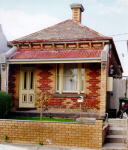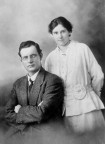|
Cottesloe is a long way from Brunswick, Melbourne, where John Curtin spent his formative adolescent and young adult years. Where Brunswick was crowded with small worker homes, narrow backyards, polluted air and noisy traffic, Cottesloe stood at a small distance from urban development in Perth. It was linked to the city and to the port of Fremantle by road and rail and was within the boundaries of the federal electorate of Fremantle, which Curtin later represented.
|

One of the houses in Brunswick, Melbourne where John Curtin lived
|
By 1923, the year the Curtins bought their block of land in Jarrad Street, Cottesloe was already a popular beach, boasting a surf lifesaving club, a promenade, sporting clubs, tea-houses and hotels.

|

Cottesloe c 1910, beach scene of swimmers
|
|
Perth notables, including members of the Forrest and Burt families, had already claimed land overlooking the western ocean where they lived in large and comfortable homes. Norfolk Pines, planted in 1909, had grown into an outstanding landscape feature, lending weight to the idea that Cottesloe was a particularly healthy part of the world.
|

Cottesloe Beach, a family enjoys an outing to the beach
|
|
John and Elsie Curtin moved to Cottesloe first in 1918, the same year as mine owner and entrepreneur Claude de Bernales. The beachside suburb showed several gradations of difference in its housing stock.
|

John and Elsie Curtin in 1917
|
| Claude de Bernales and John Curtin could not have
been more different. Bernales was an outgoing, extroverted, wealthy man,
whose large house, Overton, looked over the ocean. (Overton Lodge is now
the Cottesloe Civic Centre).
|

Overton Lodge, former home of Claude de Bernales
|
|
John Curtin was a passionate socialist, member of the Australian Labor Party and newly appointed editor of the Westralian Worker. The Curtins rented a small dwelling in Napier Street. However, the beach was a democratic forum where class, wealth and politics could be momentarily forgotten. |

The beach at Cottesloe, Christmas 1929
|
|

|

